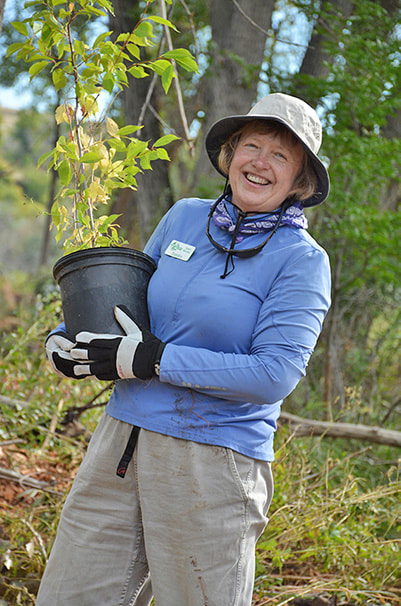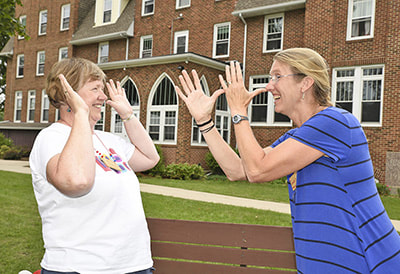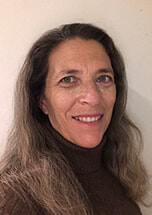 By SANDRA LAURSEN In 2017 my women’s chorus, Resonance Women’s Chorus of Boulder, learned a piece called “Where the Music Comes From,” with words and music by Lee Hoiby: I want to be where the music comes from, Where the clock stops, where it’s now. I want to be with the friends around me, Who have found me, who show me how. I want to sing to the early morning, See the sunlight melt the snow. And oh, I want to grow.  I want to wake to the living spirit Here inside me where it lies. I want to listen till I can hear it, Let it guide me, and realize That I can go with the flow unending, That is blending, that is real, And oh, I want to feel. I want to walk in the earthly garden, Far from cities, far from fear. I want to talk to the growing garden, To the devas,* to the deer, And to be one with the river flowing, Breezes blowing, sky above, *In the Hindu tradition, devas are spirits of nature, embodying forces for all living beings.
The song’s sentiments, phrases such as “the living spirit,” and the composer’s name caught my eye as suspiciously Grundtvigian. With a bit of research I learned that Hoiby indeed had Danish roots. His great-grandfather was a violinist in Denmark, and his piano teacher Gunnar Johansen was born in Copenhagen. Hoiby (1926-2011) was born in Wisconsin and educated at the University of Wisconsin-Madison, Mills College, and the Curtis Institute of Music, where he studied with Gian-Carlo Menotti. Menotti produced Hoiby’s first opera at the Spoleto Festival, thus launching a career as a pianist and composer of operas, art songs, and choral works. Throughout his career, Hoiby firmly resisted atonal and minimalist music that was popular in the 1960s. Critics called his music “simple, romantic, traditional, and cosmopolitan,” and saw him as a throwback. His lack of willingness to follow current musical fashion meant his career never really caught fire. But singers adored his compositions: the great diva Leontyne Price championed Hoiby’s works and sang them many times. “Singers, you can’t fool them,” said Hoiby. “When they hear a song, they can tell right away if it’s going to make them sound good. And mine do.” Among Hoiby’s better known works include Summer and Smoke, an opera based on the Tennessee Williams play I believe “Where the Music Comes From” was influenced by Hoiby’s Danish roots and the ideas of 19th century pastor and philosopher N.F.S. Grundtvig (1783-1872). Grundtvig challenged the standard Calvinist doctrine of the time to say that people should not be focused on the afterlife: Don’t go around being pious just to get into heaven but live in the here and now. Heaven is on earth –– in the natural world and in the love and fellowship with others that we experience in community. When we receive the big and marvelous gift of life on this planet with an open heart, we experience the divine in being joyful and grateful in our daily lives –– this is the “living spirit” inside us all. While Grundtvig couched these ideas in Christian terms, they resonate with many other spiritual traditions. As my yoga teacher says, Live in the present. Be here now. My family attends summer folk camp at Danebod Folk School, a week of fellowship and lifelong learning. When I sing “I want to be where the music comes from,” I visualize the morning sun streaming into the hundred-year-old music hall at Danebod, where we begin to “sing to the early morning” at 8:45 am. “The clock stops” as over and over we choose old favorites from World of Song; those folk songs have the same lilt to my ear as the up-and-down waltz rhythm of “Where the Music Comes From.” In 2017, when my sister and I were August folk camp directors, we included this song on the song sheet, because it fit our camp spirit so very perfectly. This year’s August camp theme, “Joy of Living,” brought Hoiby’s song to mind again. His lyrics urge us to plunge into the wide stream of life, to join “the flow unending.” His vision is one of harmony with nature but, importantly, it is not escapist: we find solace and inspiration in nature, but also in human community, whether by singing, growing gardens, or walking in them together. At folk camp, the friends around me “show me how”— when they teach a new dance, demonstrate a new crafting skill, or challenge my ideas in morning discussion, but also when they model activism against injustice or embody graceful living in the face of grief, aging, and change. Music is integrally bound with the joy of living. Hoiby liked to quote Haydn’s statement that music is “balm for the soul after a hard day’s work.” He felt that music must be “a song from the heart… full of feeling, [making] you feel the rhythm of it that goes along with the rhythm of life, which begins with the beating of the heart.” We all live where the music comes from. Sources:
[email protected]
0 Comments
Leave a Reply. |
Editor InformationBridget Lois Jensen Archives
March 2023
|
Subscribe | Gift |
Submit an Article |
Contact |
© COPYRIGHT 2019 CHURCH AND LIFE.
|

 RSS Feed
RSS Feed